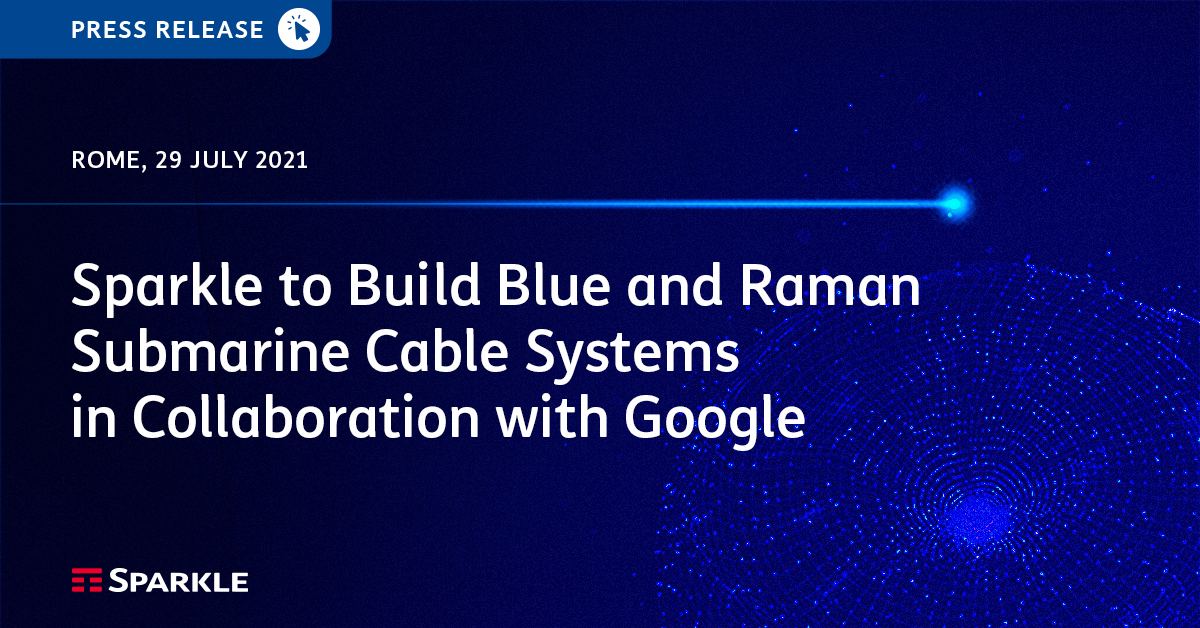Sparkle to Build Blue and Raman Submarine Cable Systems in Collaboration with Google Cloud
Each cable system will contain 16 fiber optic pairs while adhering to the innovative concepts of open cable, supporting multiple fiber tenants, and open landing station, enabling competitive access to the cable termination points, the two systems set a new reference in terms of diversification, scalability and latency throughout these geographies.
Blue will be deployed along a new northbound route in the Mediterranean, crossing the Strait of Messina, rather than following the traditional route through Sicily Channel.

As a result, Internet Service Providers, Carriers, Telecom Operators, Content Providers, Enterprises and Institutions will benefit from high-speed Internet and state-of-the-art capacity services with unparalleled diversity and performances.
Within the Blue System, BlueMed submarine cable is now Sparkle’s own private domain sharing its wet components with four additional fibre pairs and an initial design capacity of more than 25 Tbps per fibre pair, and is extended up to Jordan (Aqaba) with additional private branches into France (Corsica), Greece (Chania – Crete), Italy (Golfo Aranci – Sardinia and Rome), Algeria, Tunisia, Libya, Turkey, Cyprus and more in the future.
BlueMed flexible design allows both seamless express connections throughout the Mediterranean Basin, with unprecedented latency and spectral efficiency, and sophisticated regional subsystems, based on specific customer requirements.
In addition, Sparkle’s Genoa Open Landing Platform is set to become the alternative priority access for other upcoming submarine cables looking for a diversified entry to Europe, backhauled to the Milan’s rich digital marketplace, and thus a new reference gateway between Africa, the Middle East, Asia and Europe.
Blue and Raman are expected to be ready for service in 2024, with the Tyrrhenian part of BlueMed planned to be operational already in 2022.
“We are extremely proud to bring our collaboration with Google to the next level with this cutting-edge intercontinental infrastructure”, comments Elisabetta Romano, CEO of Sparkle. “With Blue and Raman Submarine Cable Systems, Sparkle boosts its capabilities in the strategic routes between Asia, Middle East and Europe and the enhanced BlueMed strengthens our presence in the greater Mediterranean area”
2 thoughts on “Sparkle to Build Blue and Raman Submarine Cable Systems in Collaboration with Google Cloud”
Comments are closed.



US internet giant Google has finished laying an undersea cable that runs from New York to Bude in Cornwall and Bilbao, Spain.
https://blog.google/around-the-globe/google-europe/united-kingdom/our-grace-hopper-subsea-cable-has-landed-uk/
“As our first Google-funded cable to the UK, Grace Hopper is part of our ongoing investment in the country, supporting users who rely on our products and customers using our tools to grow their business,” said the blog. Why do commercial companies insist on framing their investments as acts of philanthropy? Google laid the cable so it could flog more cloud stuff to UK customers. Why not just say so?
“With this in mind, improving the diversity and resilience of Google’s network is crucial to our ability to continue supporting one of the UK’s most vital sectors, as well as its long-term economic success,” persists the blog.
Anyway, of course it’s good to have a new 16-fibre pair undersea cable connecting us with the world’s biggest economy, but if all it does is improve Google Cloud services then it may fall short of sparking a new tech sector renaissance in this country. Unless Google’s philanthropic urges run to letting other companies play with its toys, that is.
https://telecoms.com/511359/google-lays-some-cable-in-cornwall/
Google, Meta, Microsoft & Amazon use 66% of the world’s undersea fiber-optic capacity! The four tech giants increasingly dominate the internet’s critical cable infrastructure
Fiber-optic cable, which carries 95% of the world’s international internet traffic, links up pretty much all of the world’s data centers, those vast server warehouses where the computing happens that transforms all those 1s and 0s into our experience of the internet.
Where those fiber-optic connections link up countries across the oceans, they consist almost entirely of cables running underwater—some 1.3 million kilometers (or more than 800,000 miles) of bundled glass threads that make up the actual, physical international internet. And until recently, the overwhelming majority of the undersea fiber-optic cable being installed was controlled and used by telecommunications companies and governments. Today, that’s no longer the case.
In less than a decade, four tech giants— Microsoft, Google parent Alphabet, Meta (formerly Facebook ) and Amazon —have become by far the dominant users of undersea-cable capacity. Before 2012, the share of the world’s undersea fiber-optic capacity being used by those companies was less than 10%. Today, that figure is about 66%.
By building their own cables, the tech giants are saving themselves money over time that they would have to pay other cable operators. That means the tech companies don’t need to operate their cables at a profit for the investment to make financial sense.
The ability of these companies to vertically integrate all the way down to the level of the physical infrastructure of the internet itself reduces their cost for delivering everything from Google Search and Facebook’s social networking services to Amazon and Microsoft’s cloud services. It also widens the moat between themselves and any potential competitors.
“You have to imagine this investment will ultimately make them more dominant in their industries, because they can provide services at ever-lower costs,” says Mr. Meltzer.
https://www.wsj.com/articles/google-amazon-meta-and-microsoft-weave-a-fiber-optic-web-of-power-11642222824